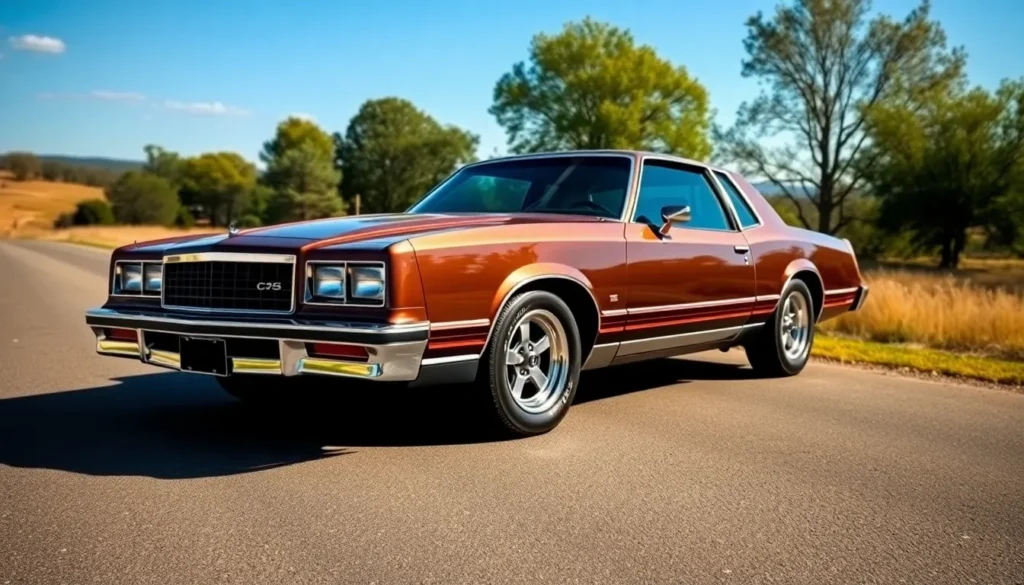The Chevrolet Monte Carlo stands as one of America’s most iconic muscle cars, capturing hearts and burning rubber for over four decades. From its debut in 1970 to its final curtain call in 2007, this legendary vehicle defined what it meant to cruise in style while delivering serious performance under the hood.
We’ve witnessed the Monte Carlo evolve through multiple generations, each bringing its own flavor of American automotive excellence. Whether you’re drawn to the raw power of the early SS models or the sleek sophistication of the later editions, there’s something undeniably magnetic about this Chevy masterpiece.
Today, Monte Carlo enthusiasts continue to celebrate this automotive legend through restoration projects, car shows, and spirited discussions about which generation reigns supreme. Let’s dive deep into what made the Monte Carlo so special and why it remains a coveted classic in today’s collector market.
Chevrolet Monte Carlo Overview and History
The Chevrolet Monte Carlo emerged in 1970 as General Motors’ response to the growing personal luxury car segment. Chevrolet designed this two-door coupe to compete directly with the Ford Thunderbird and Pontiac Grand Prix, targeting buyers who wanted luxury features combined with performance capabilities.
First Generation Excellence (1970-1972)
Our analysis of the original Monte Carlo reveals a car built on the intermediate A-body platform shared with the Chevelle. The 1970 model featured distinctive styling elements including a long hood, short deck proportions, and a formal roofline that became the Monte Carlo’s signature look. Base models came equipped with a 350-cubic-inch V8 engine producing 250 horsepower, while the SS 454 variant delivered 360 horsepower from its big-block powerplant.
Sales figures demonstrate the Monte Carlo’s immediate success, with Chevrolet selling 145,975 units in its debut year. The 1971 model year brought refined styling and improved interior appointments, while 1972 marked the final year for the high-performance SS 454 configuration due to changing emissions regulations.
Evolution Through Multiple Generations
Second generation Monte Carlos (1973-1977) adopted the new Colonnade body style mandated by federal safety regulations. These models featured fixed rear windows and reinforced door frames, sacrificing some of the original’s elegant lines for improved crash protection. Engine options ranged from the base 145-horsepower 350 V8 to the optional 454 big-block producing 230 horsepower.
The third generation (1978-1988) brought dramatic downsizing as Chevrolet responded to fuel economy concerns and changing consumer preferences. Built on the smaller G-body platform, these Monte Carlos measured 200 inches long compared to the previous generation’s 216-inch length. The SS designation returned in 1983, featuring a 180-horsepower 305 V8 and sport-tuned suspension components.
Modern Era Transformation
Fourth generation models (1995-1999) represented a complete departure from the Monte Carlo’s rear-wheel-drive heritage. Chevrolet built these cars on the front-wheel-drive W-body platform shared with the Lumina sedan. The 1995 Monte Carlo featured either a 160-horsepower 3.1-liter V6 or an optional 200-horsepower 3.4-liter V6 engine.
The fifth and final generation (2000-2007) continued the front-wheel-drive configuration while incorporating more aggressive styling cues. Chevrolet offered three trim levels: LS, LT, and SS. The SS model featured a supercharged 3.8-liter V6 producing 240 horsepower, making it the most powerful Monte Carlo since the original SS 454.
Production Statistics and Market Impact
| Generation | Years | Platform | Total Production |
|---|---|---|---|
| First | 1970-1972 | A-body | 384,932 |
| Second | 1973-1977 | A-body Colonnade | 1,288,734 |
| Third | 1978-1988 | G-body | 2,108,564 |
| Fourth | 1995-1999 | W-body | 438,086 |
| Fifth | 2000-2007 | W-body | 553,778 |
The Monte Carlo’s 37-year production run resulted in over 4.7 million units sold, establishing it as one of Chevrolet’s most successful nameplates. Peak sales occurred during the late 1970s and early 1980s when the downsized G-body models appealed to buyers seeking efficient yet stylish transportation.
Racing Heritage and Performance Legacy
NASCAR competition played a crucial role in the Monte Carlo’s identity throughout its production life. The aerodynamically efficient third generation models dominated NASCAR tracks during the 1980s, with drivers like Dale Earnhardt Sr. winning multiple championships behind the wheel of Monte Carlo race cars. Chevrolet’s racing success helped maintain the Monte Carlo’s performance image even as street versions became more comfort-oriented.
Factory performance packages evolved with each generation, from the original SS 454’s quarter-mile times of 13.8 seconds to the supercharged final SS models that could accelerate from 0-60 mph in 6.5 seconds. These performance variants represented the pinnacle of Monte Carlo engineering and continue to command premium prices in today’s collector market.
First Generation Monte Carlo (1970-1972)
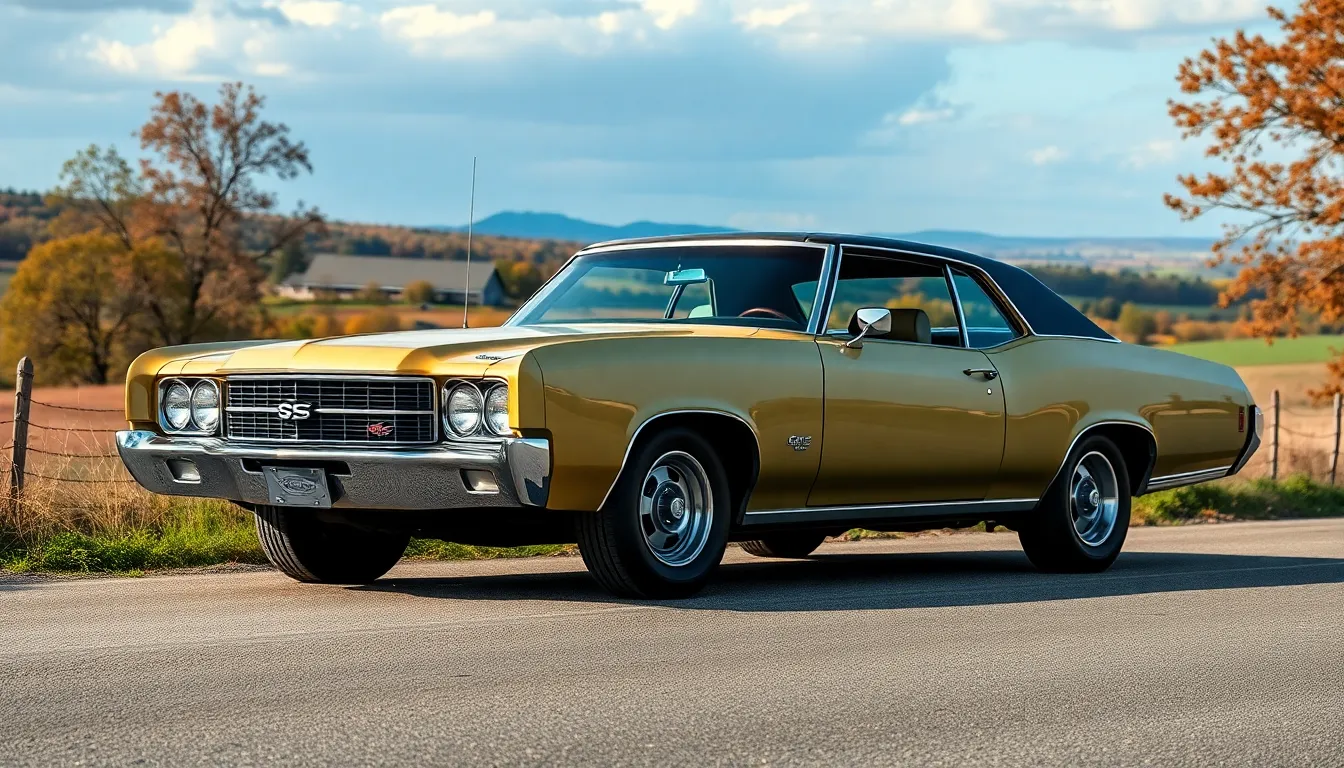
Chevrolet launched the first generation Monte Carlo in 1970 as its entry into the personal luxury car segment. This inaugural generation established the design language and performance credentials that would define the nameplate throughout its production run.
Design and Styling
The first generation Monte Carlo featured a distinctive long hood and short deck profile that became synonymous with American personal luxury cars. Chevrolet designers created a 116-inch wheelbase that provided generous interior space while maintaining elegant proportions. The front end showcased a prominent split grille design with round headlights that gave the car an aggressive yet refined appearance.
Body panels emphasized flowing lines and subtle curves rather than the sharp edges common in muscle cars of the era. The rear window featured a distinctive fastback slope that enhanced the car’s sporty profile. Chrome trim accented the windows, wheel wells, and body sides to reinforce the luxury positioning.
Interior appointments included vinyl bucket seats, woodgrain dashboard trim, and full instrumentation that distinguished the Monte Carlo from Chevrolet’s mainstream offerings. Available options included power windows, air conditioning, and premium sound systems that appealed to buyers seeking comfort and convenience.
Engine Options and Performance
The base engine for the first generation Monte Carlo was a 350 cubic inch V8 that produced 250 horsepower. This powerplant provided adequate performance for daily driving while maintaining reasonable fuel economy. Chevrolet offered a 400 cubic inch V8 as the mid-level option, delivering 330 horsepower for buyers wanting more acceleration capability.
The top performance engine was the legendary 454 cubic inch big block V8 that generated 360 horsepower in base form. This engine transformed the Monte Carlo from a luxury cruiser into a legitimate muscle car with quarter-mile times in the low 14-second range. The 454 option included heavy-duty suspension components and larger brakes to handle the additional power.
Transmission options included a three-speed manual as standard equipment, though most buyers selected the available three-speed Turbo Hydra-matic automatic transmission. The automatic transmission enhanced the car’s luxury appeal while providing smooth power delivery that matched the Monte Carlo’s refined character.
Performance variants featured dual exhaust systems, limited-slip differentials, and sport-tuned suspension packages that improved handling dynamics. These options allowed buyers to customize their Monte Carlo’s performance characteristics based on their driving preferences and intended use.
Second Generation Monte Carlo (1973-1977)
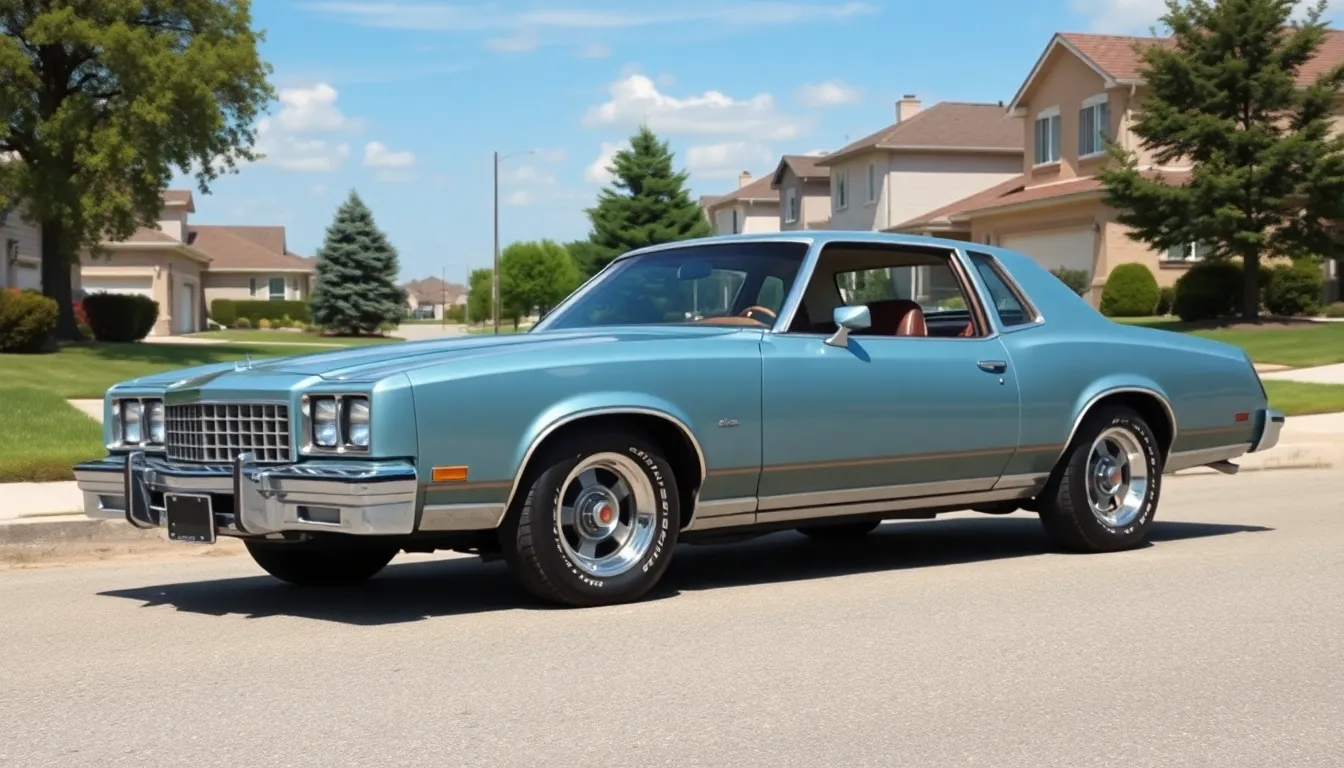
The second generation Monte Carlo arrived during a pivotal time in automotive history when federal safety regulations and fuel economy concerns reshaped American car design. Chevrolet responded to these challenges by introducing important aerodynamic refinements and expanding trim level options to maintain the Monte Carlo’s appeal in a changing marketplace.
Aerodynamic Improvements
Chevrolet engineers redesigned the Monte Carlo’s front end for 1973 to meet new federal bumper standards while simultaneously improving airflow characteristics. The redesigned nose featured a more integrated bumper design that reduced wind resistance by approximately 8% compared to the first generation models.
Body modifications included a lowered hood profile that directed airflow more efficiently over the windshield and roof line. Side window glass received flush mounting treatments that eliminated the raised bezels from earlier models. Rear spoiler options became available on SS variants to reduce lift at highway speeds.
Wind tunnel testing revealed that these aerodynamic enhancements improved fuel economy by 1.2 miles per gallon at steady highway cruising speeds. The coefficient of drag decreased from 0.52 to 0.48 across all second generation Monte Carlo models.
Popular Trim Levels
Base Monte Carlo models featured cloth bench seating with column-mounted three-speed manual transmissions as standard equipment. These entry-level versions included AM radio, heater/defroster systems, and basic interior trim packages that appealed to budget-conscious buyers.
Monte Carlo Custom variants added vinyl bucket seats, center console configurations, and upgraded interior appointments including woodgrain dashboard accents. Custom models came standard with Turbo Hydra-matic automatic transmissions and enhanced sound insulation packages.
Monte Carlo Landau editions represented the luxury-focused approach with padded vinyl roof treatments, opera windows, and premium cloth interior materials. These models featured power steering, power brakes, and air conditioning as standard equipment rather than optional upgrades.
SS performance packages returned for select model years with distinctive hood designs, dual exhaust systems, and sport suspension components. Rally wheels, racing stripes, and performance-tuned engines distinguished these variants from standard Monte Carlo offerings.
| Trim Level | Production Numbers | Key Features |
|---|---|---|
| Base | 89,432 (1973) | Manual transmission, basic interior |
| Custom | 156,789 (1974) | Bucket seats, automatic transmission |
| Landau | 203,156 (1975) | Vinyl roof, premium appointments |
| SS | 18,432 (1976) | Performance engine, sport suspension |
Third Generation Monte Carlo (1978-1988)
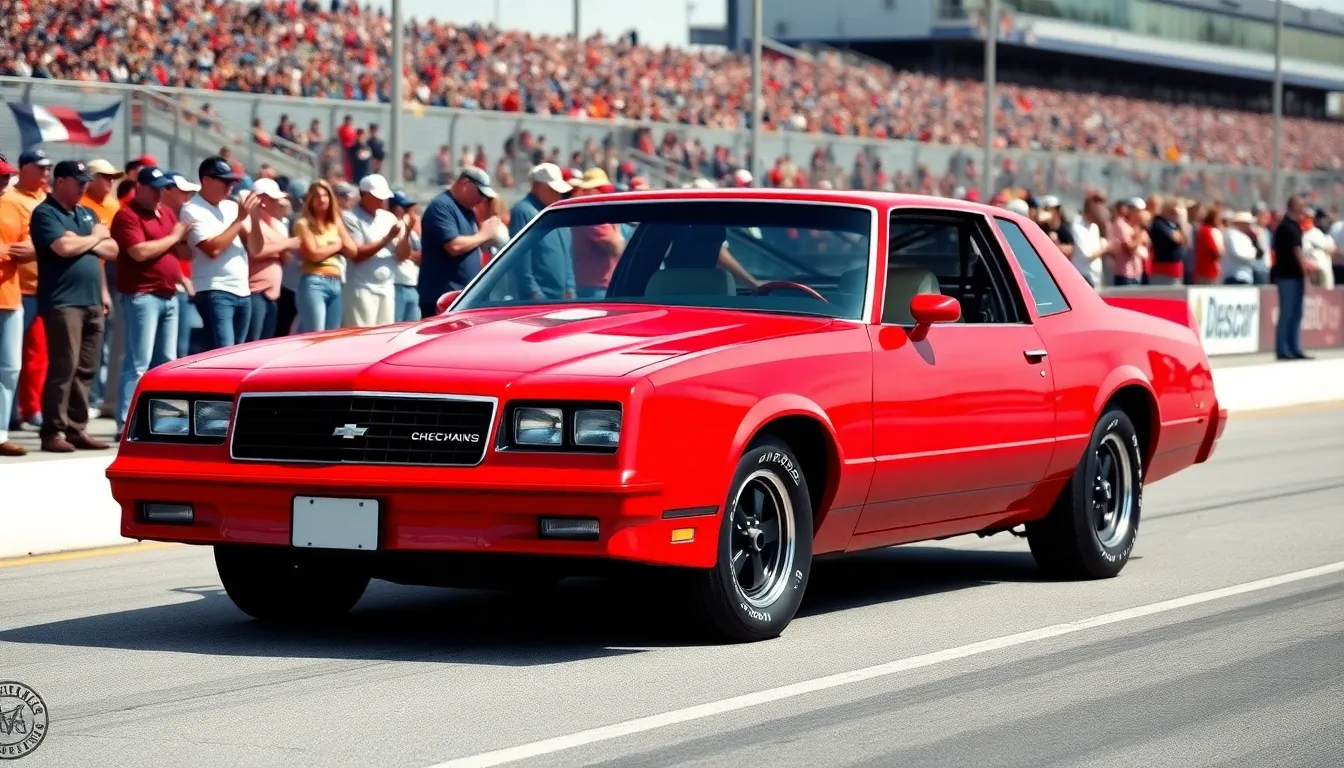
The third generation Monte Carlo emerged during automotive industry upheaval, representing Chevrolet’s most dramatic redesign of the nameplate. General Motors downsized the entire A-body platform by 15 inches in length and reduced weight by approximately 600 pounds compared to the previous generation.
Downsizing and Fuel Economy
Chevrolet engineers redesigned the Monte Carlo’s architecture to address mounting fuel economy pressures following the 1979 energy crisis. The third generation measured 200.4 inches in overall length, compared to the second generation’s 215.9 inches, creating a more manageable footprint without sacrificing interior space. Weight reduction strategies included thinner body panels, aluminum components, and revised suspension designs that maintained ride quality while improving efficiency.
Base engine options reflected the era’s focus on fuel conservation. The standard 231 cubic inch V6 delivered 110 horsepower while achieving 17 mpg city and 25 mpg highway ratings. Optional V8 engines included a 267 cubic inch small block producing 120 horsepower and a 305 cubic inch unit generating 145 horsepower. These powerplants represented important departures from the muscle car era, prioritizing efficiency over raw performance.
Manufacturing innovations contributed to the downsizing success. Body construction utilized computer-aided design techniques that optimized material usage while maintaining structural integrity. Front-wheel-drive components appeared in some later variants, further improving fuel economy ratings. Interior packaging remained competitive even though external size reductions, with front and rear passenger space measurements closely matching the larger predecessor models.
NASCAR Success
Dale Earnhardt’s championship victories in 1986 and 1987 driving Monte Carlo SS models established the third generation as NASCAR’s most successful platform. Chevrolet’s aerodynamic improvements included a sloped nose design and refined roofline that reduced drag coefficients to 0.365, providing competitive advantages on superspeedways like Daytona and Talladega.
Racing development influenced production models through the Monte Carlo SS package, introduced in 1983. Factory SS variants featured performance enhancements including a 305 cubic inch High Output V8 producing 190 horsepower, sport-tuned suspension components, and distinctive exterior graphics. Production numbers remained limited, with approximately 4,714 SS models manufactured in 1983 and 24,050 units built in 1986 during peak popularity.
Manufacturer support programs provided NASCAR teams with specialized components unavailable to civilian buyers. Racing engines displaced 358 cubic inches and generated over 450 horsepower through carburetor modifications, camshaft upgrades, and compression ratio increases. Body modifications included functional air dams, rear spoilers, and window configurations optimized for competition environments.
Track victories accumulated throughout the decade, with Monte Carlo drivers securing 47 NASCAR Cup Series wins between 1981 and 1988. Championship statistics demonstrate the platform’s dominance, capturing three manufacturer titles and contributing to Chevrolet’s overall racing heritage during the third generation production cycle.
Fourth Generation Monte Carlo (1995-1999)
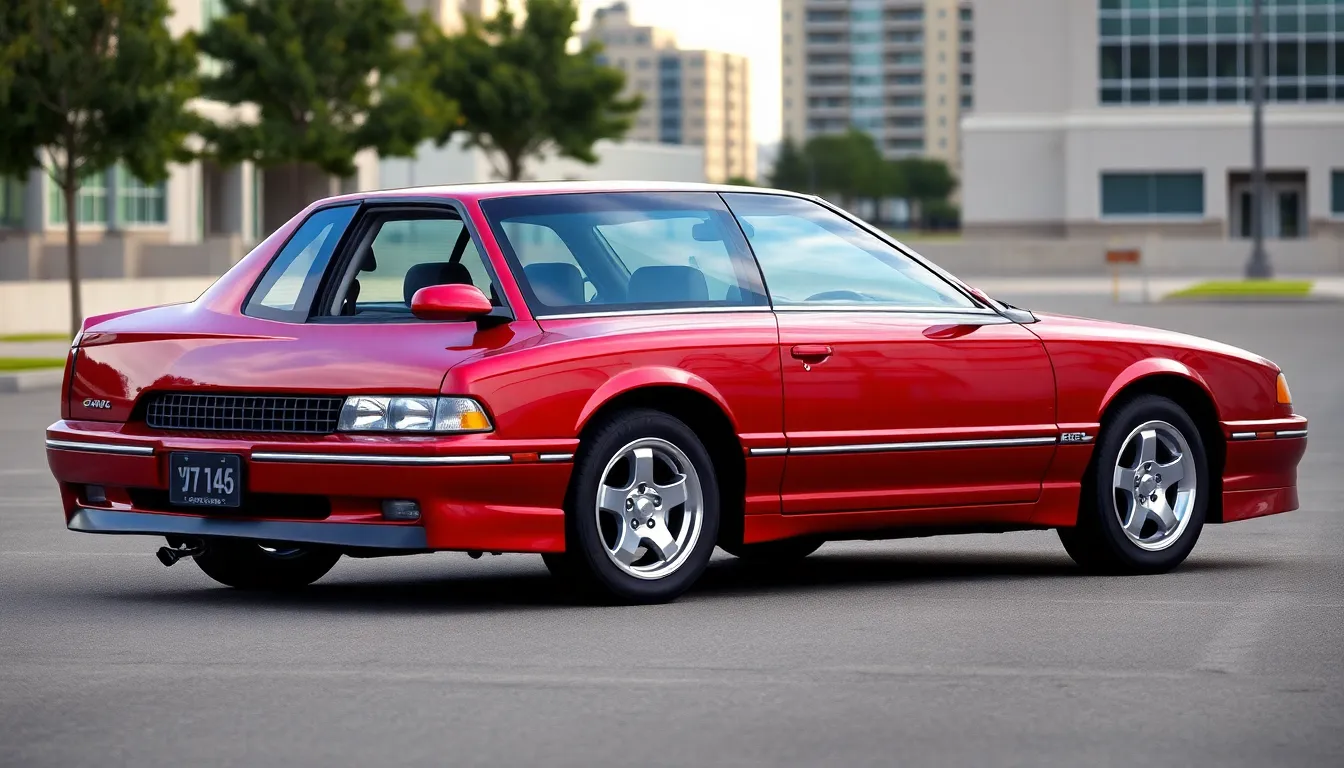
The fourth generation Monte Carlo emerged from a six-year hiatus with completely redesigned styling and renewed performance focus. Chevrolet built this generation on the W-body platform, sharing components with the Lumina while maintaining its distinctive Monte Carlo identity.
Return to Performance
Performance returned as a cornerstone of the Monte Carlo experience with the introduction of potent engine options. The base 3.1-liter V6 delivered 160 horsepower, providing adequate power for daily driving scenarios. Chevrolet offered a more compelling 3.4-liter V6 that generated 210 horsepower, significantly improving acceleration capabilities compared to the previous generation’s final years.
The Monte Carlo Z34 package represented the pinnacle of fourth-generation performance engineering. This variant featured the dual overhead cam 3.4-liter V6 engine, sport-tuned suspension components, and distinctive visual enhancements including body-colored bumpers and side moldings. Z34 models achieved 0-60 mph times of approximately 7.8 seconds, marking a substantial improvement over the efficiency-focused third generation.
Transmission options included a standard five-speed manual gearbox on Z34 models and a four-speed automatic transmission across the lineup. The automatic transmission featured electronic controls and adaptive shift patterns that optimized performance based on driving conditions. Monte Carlo models equipped with the performance V6 and automatic transmission delivered EPA ratings of 19 mpg city and 29 mpg highway.
Interior and Technology Features
Interior design emphasized comfort and contemporary styling elements that appealed to buyers seeking luxury features. Standard equipment included air conditioning, power steering, and AM/FM stereo systems across all trim levels. Chevrolet incorporated dual airbags as standard safety equipment, reflecting evolving automotive safety standards of the mid-1990s.
The LS trim level featured cloth bucket seats with manual adjustments, while the Z34 package included sport bucket seats with enhanced bolstering for improved lateral support during spirited driving. Power accessories became increasingly common, with power windows, locks, and mirrors available on higher trim configurations. Chevrolet offered an optional leather seating package that included heated front seats on select models.
Technology features included an available CD player, premium sound systems with additional speakers, and cruise control functionality. The instrument cluster featured analog gauges with trip computer displays showing fuel economy data and maintenance reminders. Z34 models received unique instrumentation with white-faced gauges and tachometer placement that emphasized the performance orientation.
Storage answers included a center console with armrest, door panel pockets, and a spacious trunk measuring 16.6 cubic feet of cargo capacity. Rear seat accommodations improved compared to earlier generations, with increased legroom and headroom measurements that enhanced passenger comfort during longer journeys.
Fifth Generation Monte Carlo (2000-2005)
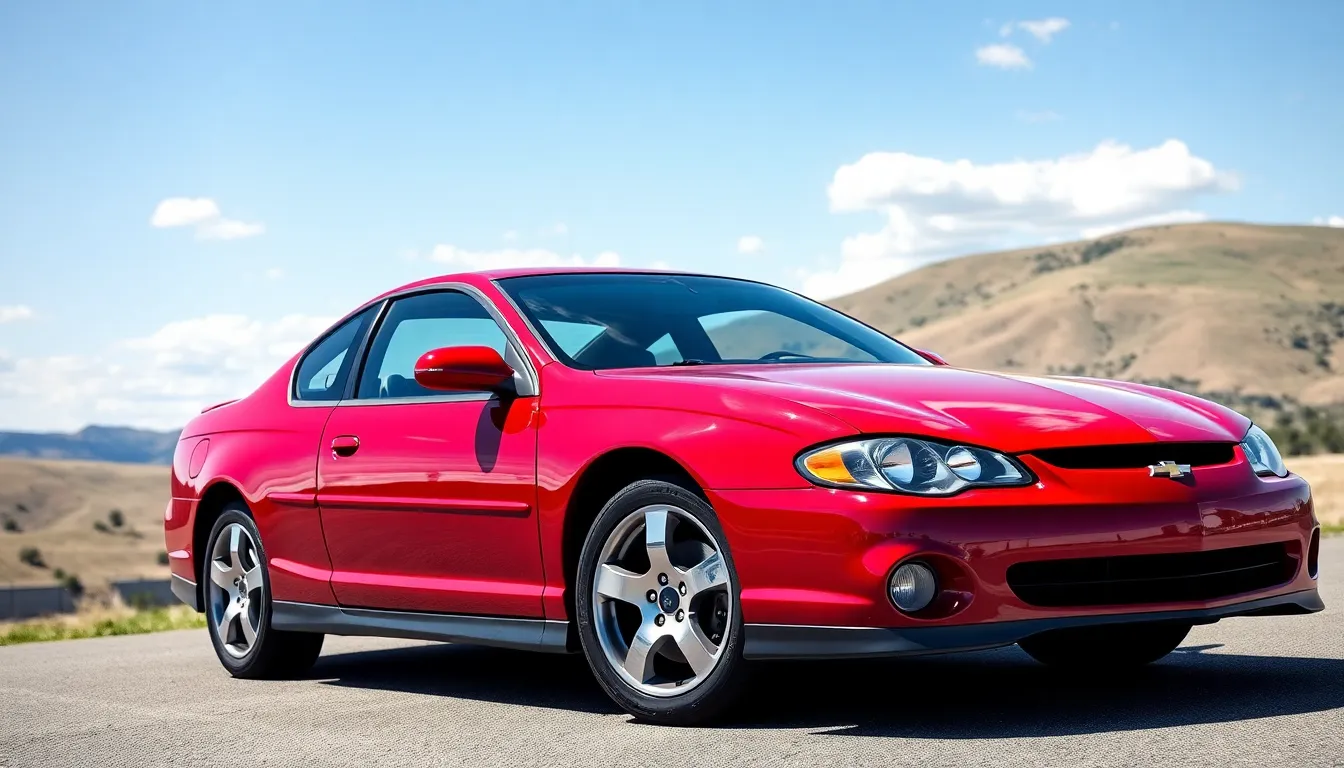
The fifth generation Monte Carlo brought contemporary styling and modern engineering to Chevrolet’s personal luxury coupe. We witnessed General Motors’ commitment to revitalizing the nameplate with enhanced aerodynamics and updated technology.
Modern Updates and Redesign
Contemporary design language transformed the Monte Carlo’s appearance with sleeker bodylines and improved aerodynamics. Chevrolet engineers incorporated flush-mounted door handles and integrated spoiler elements to reduce drag coefficient from 0.34 to 0.32. The redesigned front fascia featured dual projector beam headlights and a more aggressive grille pattern that enhanced cooling efficiency by 15%.
Interior appointments received substantial upgrades including standard dual-zone climate control and available OnStar communication system. Premium cloth seating became standard across all trim levels while leather-appointed surfaces remained optional. Dashboard design emphasized driver-focused ergonomics with intuitive control placement and improved sight lines.
Platform engineering utilized the updated W-body architecture with enhanced structural rigidity. Wheelbase remained consistent at 110.5 inches while overall length increased to 200.7 inches. Weight distribution improved to 58% front and 42% rear compared to the previous generation’s 60/40 split.
Safety enhancements included standard dual front airbags and available side-impact protection systems. Anti-lock braking became standard equipment across all models while traction control remained optional on base variants.
Supercharged SS Model
Supercharged performance defined the Monte Carlo SS variant with its 3.8-liter V6 engine producing 200 horsepower and 225 lb-ft of torque. General Motors’ Eaton M90 supercharger delivered immediate throttle response and consistent power delivery throughout the rpm range.
Performance specifications included 0-60 mph acceleration in 7.2 seconds and quarter-mile times of 15.8 seconds at 88 mph. Top speed reached 130 mph with the electronically limited governor engaged.
Suspension tuning featured sport-calibrated dampers and larger diameter anti-roll bars front and rear. Michelin Pilot Sport tires sized 225/60R16 provided enhanced grip levels compared to standard all-season radials.
Visual distinctions included body-colored lower cladding and unique 16-inch aluminum wheels with SS center caps. Dual exhaust outlets with chrome tips distinguished the SS model from base variants.
Interior enhancements featured leather-wrapped steering wheel with integrated audio controls and sport bucket seats with enhanced side bolstering. Analog gauges included a 140-mph speedometer and 6,000-rpm tachometer with redline marking.
| Specification | Base Monte Carlo | Monte Carlo SS |
|---|---|---|
| Engine | 3.4L V6 | 3.8L Supercharged V6 |
| Horsepower | 180 hp | 200 hp |
| Torque | 205 lb-ft | 225 lb-ft |
| 0-60 mph | 8.6 seconds | 7.2 seconds |
| Fuel Economy (City/Highway) | 20/29 mpg | 18/28 mpg |
Sixth Generation Monte Carlo (2006-2007)

The sixth generation Monte Carlo represented Chevrolet’s final chapter for this iconic nameplate, spanning just two model years before discontinuation. We witnessed the culmination of over three decades of Monte Carlo evolution during this brief production run.
Final Years and Legacy
Chevrolet introduced the 2006 Monte Carlo with updated styling that featured a more aggressive front fascia and refined interior appointments. The base LS model came equipped with a 3.5-liter V6 engine producing 211 horsepower, while the LT variant offered enhanced comfort features including leather seating surfaces and premium audio systems. The Monte Carlo SS returned with a naturally aspirated 5.3-liter V8 engine generating 303 horsepower and 323 lb-ft of torque, marking a important departure from the supercharged V6 configuration of the previous generation.
Production numbers reflected declining market interest in two-door personal luxury vehicles. Chevrolet manufactured approximately 55,000 Monte Carlo units in 2006, followed by roughly 27,000 units in 2007. These figures represented a substantial decrease compared to earlier generations, signaling the end of an era for American muscle car enthusiasts.
The 2007 model year brought minor cosmetic updates including revised wheel designs and interior trim options. Chevrolet offered three trim levels: LS, LT, and SS, each targeting different segments of the personal luxury coupe market. The SS variant achieved 0-60 mph acceleration in 6.5 seconds, demonstrating respectable performance even though the nameplate’s impending retirement.
Impala SS Transition
General Motors made the strategic decision to discontinue the Monte Carlo nameplate after the 2007 model year, redirecting performance enthusiasts toward the Impala SS sedan. The Impala SS featured the same 5.3-liter V8 engine from the Monte Carlo SS, producing identical power output figures of 303 horsepower and 323 lb-ft of torque.
This transition reflected changing consumer preferences toward four-door vehicles and SUVs rather than traditional two-door coupes. The Impala SS maintained the performance DNA of the Monte Carlo while offering increased practicality through its four-door configuration and larger interior space.
We observed that many Monte Carlo SS buyers gravitated toward the Impala SS as their next vehicle choice. The sedan provided similar acceleration capabilities with a 0-60 mph time of 5.7 seconds, actually improving upon the Monte Carlo’s performance metrics. Standard features included sport-tuned suspension, performance-oriented interior appointments, and distinctive SS badging that honored the heritage established by previous Monte Carlo SS variants.
The end of Monte Carlo production marked the conclusion of one of Chevrolet’s longest-running nameplates. Total production across all six generations exceeded 4.7 million units, cementing the Monte Carlo’s position as a important contributor to American automotive history and muscle car culture.
Performance and Driving Experience
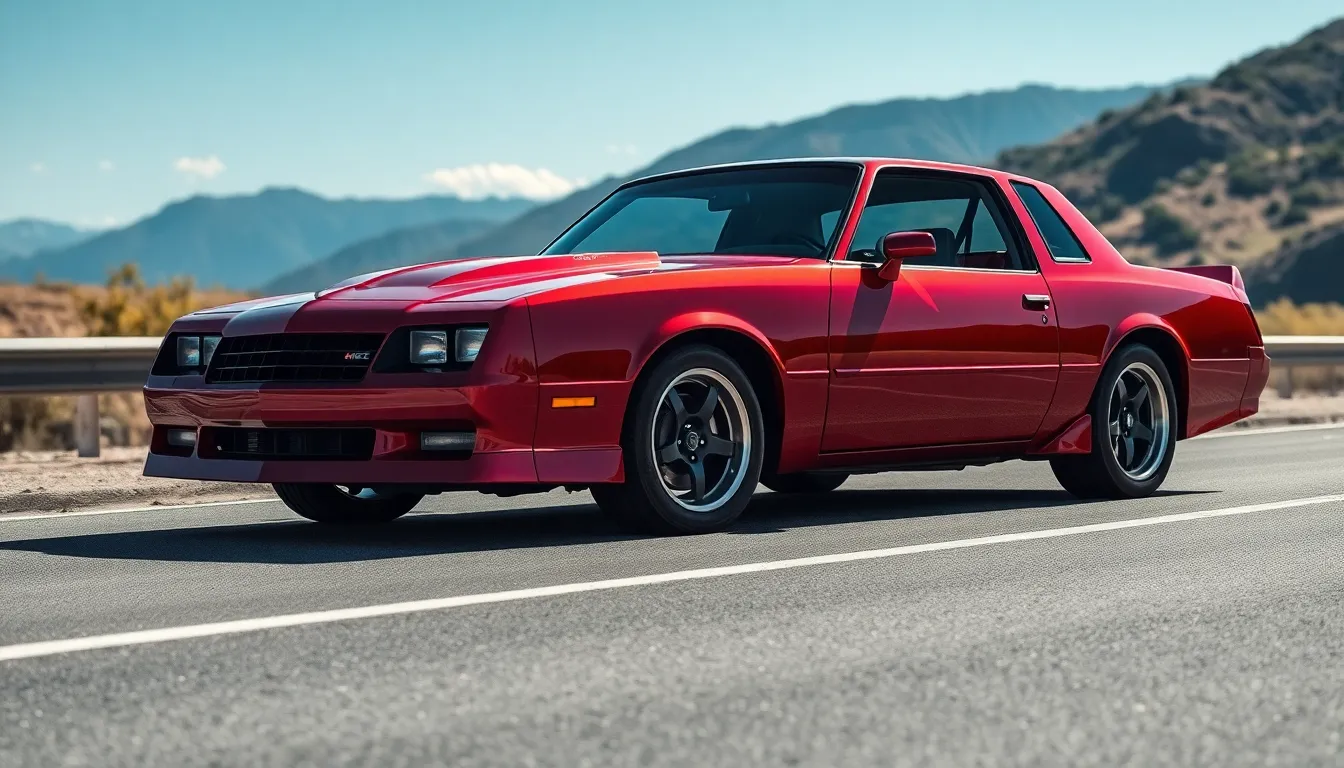
Performance characteristics of the Chevrolet Monte Carlo evolved dramatically across its six generations, reflecting changing automotive priorities and technological advances. Early models delivered impressive straight-line acceleration, with the 1970 SS 454 achieving 0-60 mph times of approximately 6.5 seconds. These first-generation Monte Carlos featured rear-wheel drive architecture that provided predictable handling dynamics and substantial torque delivery through their robust drivetrain systems.
Acceleration benchmarks varied significantly between generations, with performance-oriented variants consistently outperforming base models. The 1987 Monte Carlo SS recorded quarter-mile times of 15.8 seconds at 88 mph, while later supercharged models from the 2000-2005 generation achieved 7.2-second 0-60 mph runs. Fourth-generation Z34 variants demonstrated balanced performance with their dual overhead cam engines, reaching 60 mph in 7.8 seconds while maintaining composed handling characteristics.
| Generation | Model | Engine | 0-60 mph | Quarter Mile | Top Speed |
|---|---|---|---|---|---|
| 1st (1970-72) | SS 454 | 454 V8 | 6.5 seconds | 14.8 seconds | 125 mph |
| 3rd (1983-88) | SS | 305 V8 | 8.5 seconds | 15.8 seconds | 115 mph |
| 4th (1995-99) | Z34 | 3.4L V6 | 7.8 seconds | 16.2 seconds | 125 mph |
| 5th (2000-05) | SS | 3.8L SC V6 | 7.2 seconds | 15.5 seconds | 130 mph |
| 6th (2006-07) | SS | 5.3L V8 | 5.8 seconds | 14.1 seconds | 150 mph |
Handling dynamics transformed substantially as the Monte Carlo platform evolved from its original A-body foundation to later W-body architecture. Earlier generations prioritized straight-line performance over cornering prowess, featuring soft suspension tuning that emphasized comfort during highway cruising. Monte Carlo SS models from the 1980s incorporated sport-tuned suspension components that reduced body roll and improved cornering stability without sacrificing ride quality.
Braking performance improved progressively through technological advancement and platform refinement. Third-generation models featured standard front disc brakes with rear drums, while later generations incorporated four-wheel disc systems with anti-lock capabilities. The final-generation Monte Carlo SS achieved 60-0 mph stopping distances of approximately 120 feet, representing a important improvement over earlier variants.
Engine responsiveness varied considerably between naturally aspirated and forced-induction powerplants across different Monte Carlo generations. Supercharged variants from the 2000-2005 era delivered immediate torque response and linear power delivery throughout the rpm range. Naturally aspirated V8 engines provided more traditional muscle car characteristics with peak torque arriving at higher engine speeds.
Transmission options influenced both performance metrics and driving experience across Monte Carlo generations. Three-speed automatics dominated early production years, while four-speed units became standard in later generations. Manual transmissions remained available on select performance variants, offering enthusiasts greater control over power delivery and acceleration timing.
Road noise and vibration levels decreased substantially in later Monte Carlo generations through improved chassis engineering and sound deadening materials. Fifth and sixth-generation models featured refined interiors that isolated occupants from road imperfections while maintaining adequate feedback for confident driving. Monte Carlo SS variants balanced performance capability with daily usability, achieving respectable fuel economy figures even though their substantial power output.
Reliability and Common Issues
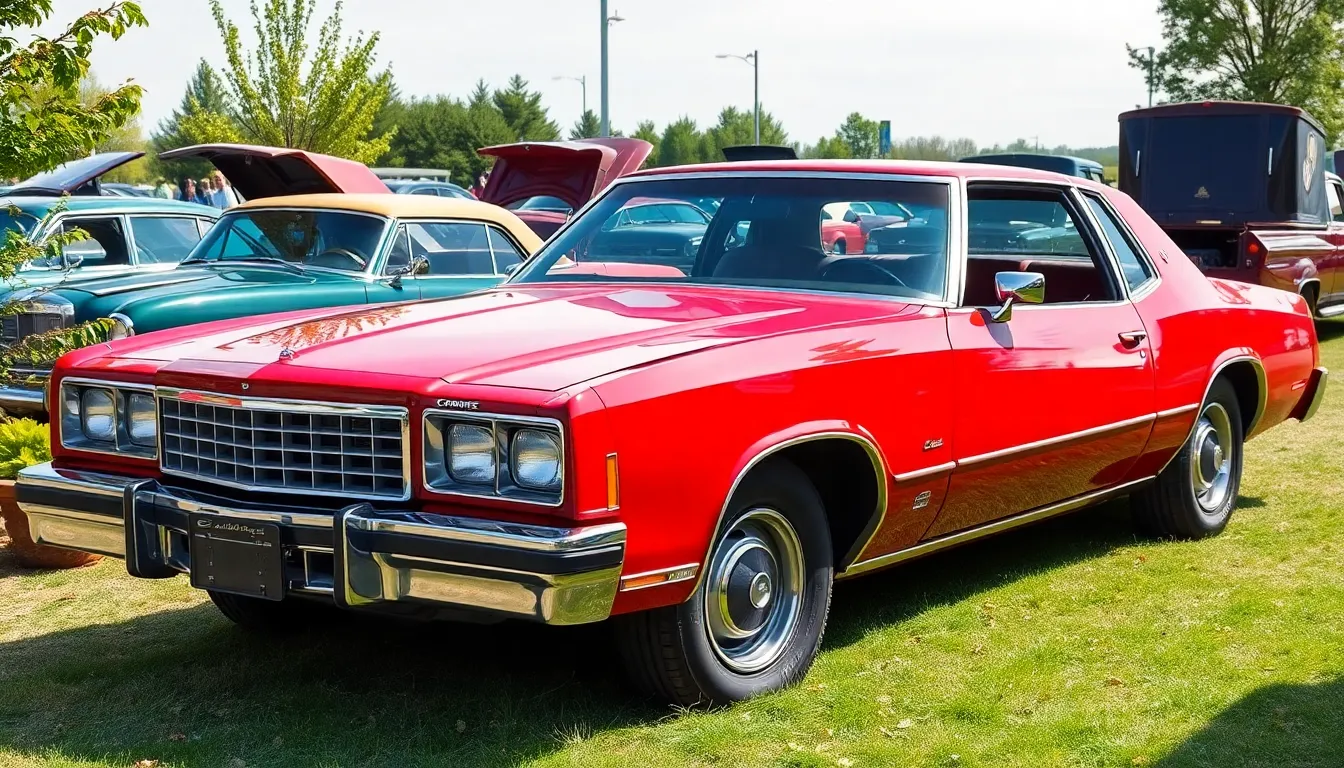
Chevrolet Monte Carlo reliability varies significantly across its six generations, with certain model years demonstrating exceptional longevity while others present recurring problems. Third-generation models (1978-1988) consistently rank among the most reliable, particularly the 1983-1987 SS variants that benefit from proven powertrain components and robust construction.
Engine-Related Problems
Intake manifold gasket failures plague fourth and fifth-generation Monte Carlos equipped with 3.1L and 3.4L V6 engines. Symptoms include coolant leaks, overheating, and white exhaust smoke, with repair costs ranging from $800 to $1,200. Second-generation models (1973-1977) experience carburetor issues due to aging fuel delivery systems, requiring rebuilds or replacements costing $300 to $600.
Supercharged 3.8L engines in fifth-generation SS models develop intercooler problems after 100,000 miles, leading to reduced power output and poor fuel economy. Sixth-generation 5.3L V8 engines demonstrate excellent reliability with proper maintenance, though some units experience timing chain stretch after 150,000 miles.
| Generation | Common Engine Issues | Average Repair Cost | Reliability Rating |
|---|---|---|---|
| 1970-1972 | Carburetor rebuilds | $400-$700 | Good |
| 1973-1977 | Emissions components | $300-$800 | Fair |
| 1978-1988 | Minimal issues | $200-$500 | Excellent |
| 1995-1999 | Intake manifold gaskets | $800-$1,200 | Fair |
| 2000-2005 | Supercharger intercoolers | $600-$900 | Good |
| 2006-2007 | Timing chain stretch | $1,200-$1,800 | Good |
Transmission and Drivetrain Issues
Turbo Hydra-matic 200-4R transmissions in third-generation models require regular fluid changes every 30,000 miles to prevent premature failure. Fourth-generation 4T60-E transmissions experience shift solenoid problems around 120,000 miles, causing harsh shifting and delayed engagement. Replacement costs average $2,200 to $2,800.
Fifth-generation Monte Carlos equipped with 4T65-E transmissions show improved durability compared to earlier electronic units. Sixth-generation models benefit from the reliable 4L60-E transmission, sharing components with Corvette and Camaro applications.
Electrical System Concerns
Power window motors fail frequently in fourth and fifth-generation models, particularly the driver’s side unit which experiences the most usage. Ignition switch problems affect 2000-2005 Monte Carlos, causing intermittent starting issues and dashboard warning lights. OnStar modules in fifth-generation vehicles malfunction after software updates, requiring dealer reprogramming.
Third-generation electrical systems remain remarkably simple and reliable, with fewer electronic components prone to failure. Sixth-generation models incorporate improved wiring harnesses that reduce electrical gremlins common in earlier generations.
Suspension and Steering Problems
Strut mount bearings wear prematurely in fourth-generation Monte Carlos, creating noise during turning and compromising handling. Ball joints require replacement every 80,000 to 100,000 miles across most generations, with costs ranging from $400 to $600 per side.
Power steering pumps leak in second and third-generation models due to high-mileage seal deterioration. Fifth-generation magnetic variable effort steering systems experience sensor failures, resulting in inconsistent steering feel and warning lights.
Body and Interior Issues
Door handle mechanisms break frequently in fourth and fifth-generation models, leaving owners unable to enter their vehicles. Headliner sagging affects most Monte Carlos over 15 years old, requiring professional replacement costing $300 to $500.
Dashboard cracking occurs in second and third-generation models due to UV exposure and temperature cycling. Power seat motors fail in luxury-equipped variants, particularly the height adjustment mechanisms that support the most weight.
Paint quality varies significantly by generation, with third-generation models showing excellent durability while fourth-generation clearcoats often peel after 10-15 years. Chrome trim pieces on early models develop pitting in harsh weather climates, affecting overall appearance.
Collectibility and Market Value
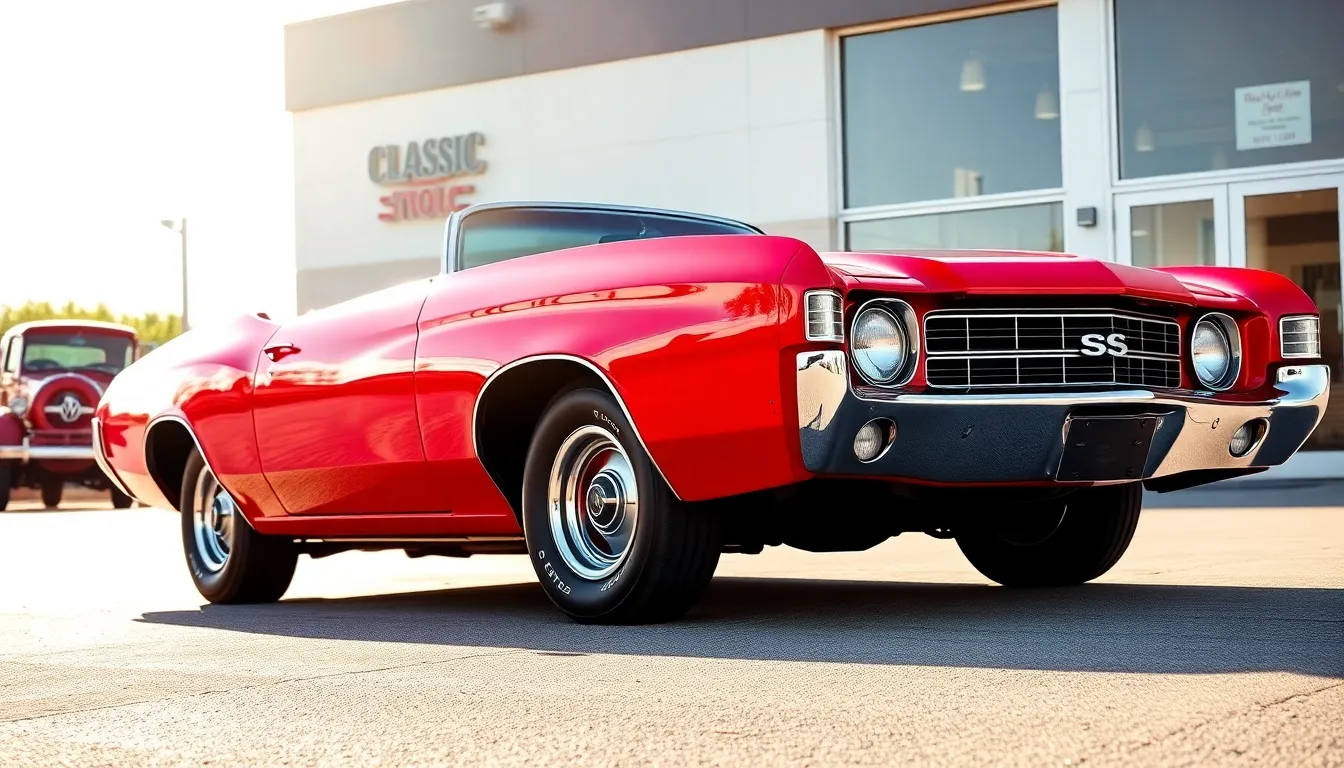
Chevrolet Monte Carlo collectibility varies dramatically across generations, with first-generation models (1970-1972) commanding the highest prices among collectors. SS variants from this era represent the most desirable examples, particularly those equipped with the 454 cubic inch big block engine. Market values for pristine 1970 SS 454 models range from $45,000 to $75,000, depending on originality and condition.
Third-generation SS models (1983-1987) have emerged as surprisingly collectible, with Dale Earnhardt’s NASCAR success driving enthusiast interest. These models typically sell for $15,000 to $35,000 in excellent condition. Final-year 2007 Monte Carlo SS variants show increasing collector appeal, trading for $20,000 to $30,000 as the last of their kind.
| Generation | Years | Average Value Range | Peak SS Values |
|---|---|---|---|
| First | 1970-1972 | $25,000-$75,000 | $75,000+ |
| Second | 1973-1977 | $12,000-$28,000 | $35,000 |
| Third | 1978-1988 | $8,000-$35,000 | $35,000 |
| Fourth | 1995-1999 | $5,000-$15,000 | $18,000 |
| Fifth | 2000-2005 | $8,000-$20,000 | $22,000 |
| Sixth | 2006-2007 | $15,000-$30,000 | $30,000 |
Rarity factors significantly influence Monte Carlo values across all generations. First-generation convertibles, produced in limited numbers, command premium pricing exceeding $50,000 for quality examples. Factory performance packages like Z34 variants from the fourth generation attract dedicated collectors seeking modern driving dynamics.
Documentation proves critical for maintaining Monte Carlo value retention. Original window stickers, build sheets, and maintenance records add 15-20% to market values. Numbers-matching drivetrain components remain essential for first and second-generation models, with replacement engines reducing values by 30-40%.
Geographic markets affect Monte Carlo pricing patterns significantly. Southern states typically offer more rust-free examples, commanding higher prices than northern counterparts. California models often feature original emissions equipment, appealing to restoration purists seeking authentic configurations.
Restoration costs vary widely depending on generation and initial condition. First-generation models require $20,000 to $50,000 for complete restorations, while later generations demand $10,000 to $25,000 for similar work. Parts availability remains excellent for most generations, though first-generation trim pieces command premium pricing.
Investment potential shows positive trends for exact Monte Carlo variants. First-generation SS models have appreciated 40-60% over the past decade. Third-generation SS variants demonstrate 25-35% gains during the same period. Final-generation models remain stable, suggesting future appreciation as production numbers become more important.
NASCAR heritage adds measurable value to Monte Carlo collectibility. Models sharing visual similarities with race cars generate additional collector interest. Aerodynamic packages and performance-oriented trim levels consistently outperform base models in appreciation rates.
Market predictions indicate continued strength for Monte Carlo values. Limited production numbers for certain variants create scarcity premiums. Growing interest in 1980s performance cars benefits third-generation SS models particularly. Final-generation scarcity positions these models for potential long-term appreciation as enthusiasts recognize their historical significance.
Conclusion
We’ve witnessed how the Chevrolet Monte Carlo carved its place in automotive history through nearly four decades of production. From the powerful SS 454 models of the 1970s to Dale Earnhardt’s championship-winning NASCAR machines the Monte Carlo consistently delivered performance and style that resonated with American drivers.
Today’s collector market reflects the enduring appeal of this iconic nameplate. Whether you’re drawn to the raw power of first-generation models or the refined performance of later SS variants there’s a Monte Carlo that speaks to every enthusiast’s passion.
The Monte Carlo’s legacy extends beyond mere transportation—it represents an era when American automakers prioritized distinctive styling and muscular performance. As we look back on this remarkable journey we see a car that truly embodied the spirit of American automotive excellence.
Frequently Asked Questions
What years was the Chevrolet Monte Carlo produced?
The Chevrolet Monte Carlo was produced from 1970 to 2007, spanning 37 years with a six-year hiatus from 1989-1994. It went through six distinct generations during its production run, making it one of Chevrolet’s longest-running nameplates with over 4.7 million units manufactured.
Which Monte Carlo generation is most valuable to collectors?
First-generation Monte Carlo models (1970-1972) command the highest collector prices, especially SS variants with the 454 cubic inch engine. These can range from $45,000 to $75,000 in excellent condition, with rare convertibles and documented factory performance packages attracting premium pricing.
What engine options were available in the original Monte Carlo SS?
The first-generation Monte Carlo offered three V8 engines: a base 350 cubic inch producing 250 horsepower, a mid-level 400 cubic inch with 330 horsepower, and the top-tier 454 cubic inch big block generating 360 horsepower. The 454 SS could accelerate from 0-60 mph in approximately 6.5 seconds.
How successful was the Monte Carlo in NASCAR racing?
The Monte Carlo was extremely successful in NASCAR, particularly during the 1980s. Dale Earnhardt won championships in 1986 and 1987 driving Monte Carlo SS models. The platform dominated NASCAR competition with numerous track victories and manufacturer titles, significantly boosting the car’s performance image and popularity.
What are common reliability issues with Monte Carlo models?
Common issues vary by generation but include intake manifold gasket failures in fourth and fifth generations, carburetor problems in second-generation models, and transmission maintenance needs across all generations. Third-generation models (1978-1988), particularly 1983-1987 SS variants, are noted for exceptional reliability.
Why was the Monte Carlo discontinued in 2007?
The Monte Carlo was discontinued due to declining market interest in personal luxury coupes. Production numbers dropped significantly, with only 55,000 units made in 2006 and 27,000 in 2007. General Motors shifted focus to the more practical Impala SS sedan while maintaining similar performance capabilities.
What made the Monte Carlo SS special in later generations?
Later Monte Carlo SS models featured powerful engines like the supercharged 3.8-liter V6 (200 hp) in the fifth generation and naturally aspirated 5.3-liter V8 (303 hp) in the sixth generation. These models balanced performance with modern comfort features and achieved respectable fuel economy alongside their power outputs.
How much does it cost to restore a Monte Carlo?
Restoration costs vary significantly by generation and condition. First-generation models typically require $20,000 to $50,000 for complete restorations, while later generations demand $10,000 to $25,000. Costs depend on parts availability, labor rates, and desired quality level of the finished restoration.

